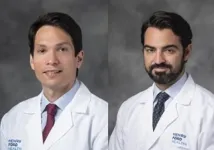(Press-News.org) Key Takeaways
Researchers have revealed the mechanisms behind mutations that cause a congenital condition called aplasia cutis congenita, in which babies are born without skin along the midline of the scalp
The mutations lead to the impairment of cells that normally express growth factors that induce skin formation over the skull
BOSTON – Children with the condition aplasia cutis congenita (ACC) are born with the absence of skin along the midline of the scalp. Depending on whether mutations are in the KCTD1 or KCTD15 genes, additional characteristics beyond the scalp—such as kidney or heart problems—are also present.
When investigators led by a team at Massachusetts General Hospital (MGH) modeled these mutations in cells and mice using genetic approaches, they found that the defects lead to the impairment of certain cells that are part of the midline cranial sutures and that these cells normally express growth factors that induce skin formation over the skull.
In a study published in The Journal of Clinical Investigation, the scientists learned that the ACC-related KCTD1 and KCTD15 mutations result in a lack of function of the KCTD1 and KCTD15 proteins expressed by these genes.
In mice, ACC occurred when these proteins were inactivated in neural crest cells of the cranial midline sutures—the fibrous joints between bones of a baby’s skull that remain flexible during infancy to allow the skull to expand as the brain grows.
Without KCTD1 and KCTD15, which interact with each other to form protein complexes within cells, neural crest cells were impaired, resulting in diminished expression of growth factors that normally stimulate the formation of skin. ‘
These findings reveal a previously unknown role of neural crest cells of midline cranial sutures for the formation of the overlying scalp skin. Experiments also revealed important roles of these proteins for the formation of skin appendages, such as hairs, sweat glands, and sebaceous glands.
“We solved a centuries-old enigma, which allows us now to explain why this congenital skin disease affects the midline scalp but not other areas of the skin,” says senior author Alexander G. Marneros, MD, PhD, a principal investigator at the Cutaneous Biology Research Center of MGH and an associate professor of Dermatology at Harvard Medical School. “In the process of this study, we also uncovered fundamental new insights into mechanisms that orchestrate skin and skin appendage formation.”
The findings may be used to develop strategies to target the anomalies associated with ACC; however additional questions remain, and more research is needed. “We are now exploring the downstream molecular mechanisms through which KCTD1 and KCTD15 complexes affect the function of cells in and around the skin during development,” says Marneros.
Additional authors include Jackelyn Raymundo, Hui Zhang, Giovanni Smaldone, Wenjuan Zhu, Kathleen E. Daly, Benjamin J. Glennon, Giovanni Pecoraro, Marco Salvatore, William A. Devine, Cecilia W. Lo, and Luigi Vitagliano.
About the Massachusetts General Hospital
Massachusetts General Hospital, founded in 1811, is the original and largest teaching hospital of Harvard Medical School. The Mass General Research Institute conducts the largest hospital-based research program in the nation, with annual research operations of more than $1 billion and comprises more than 9,500 researchers working across more than 30 institutes, centers and departments.
END
Mass General scientists help to solve the mystery of how a rare congenital scalp defect forms
Researchers have revealed the mechanisms behind mutations that cause a congenital condition called aplasia cutis congenita, in which babies are born without skin along the midline of the scalp
2024-01-03
ELSE PRESS RELEASES FROM THIS DATE:
Henry Ford Health cardiologists publish case series study on heart valve procedure
2024-01-03
DETROIT (January 3, 2024) – Findings from a published case series research letter by the Henry Ford Health Structural Heart Disease team show that severe mitral stenosis, due to a build-up of calcium deposits in the mitral valve common in elderly patients, can be safely and successfully treated using Intravascular lithotripsy (IVL)-enabled percutaneous balloon mitral valvuloplasty. However, larger prospective studies in high-risk population are needed to confirm the findings.
These key takeaways from the research letter on IVL-facilitated valvuloplasty for severely calcified mitral valve stenosis are published ...
Therapeutically harnessing cancer stem cell-derived exosomes
2024-01-03
“[...] recent significant advances in understanding [...] CSC-Exos have revealed numerous potential applications for diagnosis and treatment.”
BUFFALO, NY- January 3, 2024 – A new editorial paper was published in Oncotarget's Volume 14 on December 20, 2023, entitled, “Therapeutically harnessing cancer stem cell-derived exosomes.”
In this editorial, researcher Yong Teng from Emory University discusses cancer stem cell-derived exosomes. Cancer stem cells (CSCs), a small population of cancer cells capable of self-renewal, are thought to serve ...
Pain is a major problem for individuals with traumatic brain injury
2024-01-03
Waltham — January 3, 2024 — Chronic pain affects approximately 60% of people living with traumatic brain injury (TBI), even up to 30 years after injury, according to new research published in The Journal of Head Trauma Rehabilitation (JHTR), the official journal of the Brain Injury Association of America. The journal is published in the Lippincott portfolio by Wolters Kluwer.
"This is the first study to examine the experience of chronic pain in a large TBI sample this far post-injury," explain Cynthia Harrison-Felix, PhD, FACRM, Co-Project Director of the TBI Model System ...
Research reveals promising approach to enhance treatment for sleep apnea-related issues
2024-01-03
A groundbreaking study published in the American Journal of Respiratory and Critical Care Medicine provides new insights into the treatment of obstructive sleep apnea (OSA) and its associated health impacts.
Researchers at the University of Missouri School of Medicine and the Marshall University Joan C. Edwards School of Medicine led by David Gozal, M.D., M.B.A., Ph.D. (Hon), vice president of health affairs at Marshall University and dean of the Joan C. Edwards School of Medicine, explored innovative therapeutic strategies that could greatly advance the understanding and management of OSA-related ...
Seismic and infrasonic signals used to characterize Nord Stream pipeline events
2024-01-03
Seismic events that coincided with sudden drops in pressure within the Nord Stream 1 and 2 natural gas pipelines in September 2022 alerted the world to the rupture of pipelines in the western Baltic Sea. The suspected act of sabotage, which reportedly used explosive charges to rupture the pipelines, is still under investigation by multiple countries.
A new study published in The Seismic Record provides further evidence that the Nord Stream seismic signals came from a complex source. The signals lasted longer than would be expected from a single explosive source, the ...
Surprise! – How the brain learns to deal with the unexpected
2024-01-03
For children, the world is full of surprises. Adults, on the other hand, are much more difficult to surprise. And there are complex processes behind this apparently straightforward state of affairs. Researchers at the University of Basel have been using mice to decode how reactions to the unexpected develop in the growing brain.
Babies love playing peekaboo, continuing to react even on the tenth sudden appearance of their partner in the game. Recognizing the unexpected is an important cognitive ability. After all, new can also mean dangerous.
The exact way in which surprises are processed in the brain changes as we grow, however: unusual ...
Genetic variants underlying male bisexual behavior, risk-taking linked to more children, study shows
2024-01-03
ANN ARBOR—Because same-sex sexual behavior does not result in offspring, evolutionary biologists have long wondered how the genes associated with this behavior have persisted in the human genome, and whether they will remain in the future.
A new University of Michigan-led study, scheduled for publication Jan. 3 in the journal Science Advances, suggests that part of the explanation—specifically for male bisexuals—has to do with risk-taking behavior.
The U-M researchers analyzed data from more than 450,000 participants of European ancestry in the United Kingdom's Biobank database of genetic and health information. Participants responded to a questionnaire ...
Shining a light on the hidden damage of mild brain injuries
2024-01-03
Researchers have created a new brain imaging method that allows mild traumatic brain injuries (mTBIs) to be diagnosed, even when existing imaging techniques like magnetic resonance imaging (MRI) don’t show any structural abnormalities. The technique involves loading gadolinium, a standard MRI contrast agent, into hydrogel-based micropatches that are attached to immune cells called macrophages. mTBIs cause inflammation in the brain, which produces signals that attract macrophages to migrate there. Coupling the gadolinium contrast agent to these cells enables MRI to reveal ...
Weill Cornell Medicine receives grant for blood test to diagnose breast cancer
2024-01-03
Weill Cornell Medicine researchers received a $2.4 million grant from the U.S. Department of Defense Breast Cancer Research Program to validate a new blood test for the early detection of breast cancer.
Researchers are evaluating Syantra DX Breast Cancer (Syantra Inc.), an experimental diagnostic test that detects specific biomarkers in blood associated with breast cancer. The test uses an artificial intelligence algorithm to determine whether a patient is positive for cancer as soon as detectable by mammogram or possibly earlier, and before symptoms arise.
“This new liquid biopsy, ...
Using the body’s own cells to treat traumatic brain injury
2024-01-03
Scientists have created a new treatment for traumatic brain injury (TBI) that shrank brain lesions by 56% and significantly reduced local inflammation levels in pigs. The new approach leverages macrophages, a type of white blood cell that can dial inflammation up or down in the body in response to infection and injury. The team created disc-shaped microparticles called “backpacks” containing anti-inflammatory molecules, then attached them directly to the macrophages. These molecules kept the cells in an anti-inflammatory state ...
LAST 30 PRESS RELEASES:
University of Oklahoma researcher awarded funding to pursue AI-powered material design
Exploring how the visual system recovers following injury
Support for parents with infants at pediatric check-ups leads to better reading and math skills in elementary school
Kids’ behavioral health is a growing share of family health costs
Day & night: Cancer disrupts the brain’s natural rhythm
COVID-19 vaccination significantly reduces risk to pregnant women and baby
The role of vaccination in maternal and perinatal outcomes associated with COVID-19 in pregnancy
Mayo Clinic smartwatch system helps parents shorten and defuse children's severe tantrums early
Behavioral health spending spikes to 40% of all children’s health expenditures, nearly doubling in a decade
Digital cognitive behavioral treatment for generalized anxiety disorder
Expenditures for pediatric behavioral health care over time and estimated family financial burden
Air conditioning in nursing homes and mortality during extreme heat
The Alps to lose a record number of glaciers in the next decade
What makes a good proton conductor?
New science reporting guide published for journalists in Bulgaria
New international study reveals major survival gaps among children with cancer
New science reporting guide published for journalists in Turkey
Scientists develop a smarter mRNA therapy that knows which cells to target
Neuroanatomy-informed brain–machine hybrid intelligence for robust acoustic target detection
Eight SwRI hydrogen projects funded by ENERGYWERX
The Lundquist Institute and its start-up company Vitalex Biosciences Announces Strategic Advancement of Second-Generation fungal Vaccine VXV-01 through Phase 1 Trials under $40 Million Competitive Con
Fine particles in pollution are associated with early signs of autoimmune disease
Review article | Towards a Global Ground-Based Earth Observatory (GGBEO): Leveraging existing systems and networks
Penn and UMich create world’s smallest programmable, autonomous robots
Cleveland researchers launch first major study to address ‘hidden performance killer’ in athletes
To connect across politics, try saying what you oppose
Modulating key interaction prevents virus from entering cells
Project explores barriers to NHS career progression facing international medical graduates
Jeonbuk National University researchers explore the impact of different seasonings on the flavor perception of Doenjang soup
Two Keck Medicine of USC Hospitals named Leapfrog Top Teaching Hospitals
[Press-News.org] Mass General scientists help to solve the mystery of how a rare congenital scalp defect formsResearchers have revealed the mechanisms behind mutations that cause a congenital condition called aplasia cutis congenita, in which babies are born without skin along the midline of the scalp

